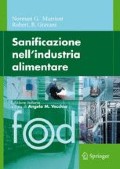Estratto
Gli stabilimenti, nuovi o ristrutturati, per la lavorazione o la somministrazione di alimenti dovrebbero essere progettati in modo da favorire l’igiene dei processi e l’efficacia della sanificazione. Poiché la maggior parte delle attrezzature e dei servizi sono progettati per risultare funzionali, occorre enfatizzare i criteri di igiene che devono ispirare la progettazione e la costruzione di uno stabilimento, in modo da garantirne la sicurezza igienica. Uno stabilimento così progettato può migliorare la salubrità di tutti gli alimenti e aumentare l’efficacia e l’efficienza del programma di sanificazione.
Access this chapter
Tax calculation will be finalised at checkout
Purchases are for personal use only
Preview
Unable to display preview. Download preview PDF.
Bibliografia
Anon. (2004) Selecting easy-to-clean conveyor belts for superior sanitation. Food Safety Mag 10;1: 46.
Butts J (2003) Seek and destroy: Identifying and controlling Listeria monocytogenes growth niches. Food Safety Mag 9;2: 24.
Ente Nazionale Itallano di Unificazione (UNI): http://www.uni.com/it/
Gingrich JB, Osterberg TE (2003) Pest birds: Biology and management at food processing facilities. In: Hui YH et al (eds) Food plant sanitation. Marcel Dekker, New York.
Graham DJ (1991a) Sanitary design-a mind set. Dairy Food Environ Sanit 11;7: 338.
Graham DJ (1991b) Sanitary design-a mind set (Part II). Dairy Food Environ Sanit 11;8: 454.
Graham DJ (1991c) Sanitary design-a mind set (Part III). Dairy Food Environ Sanit 11;9: 533.
Graham DJ (1991d) Sanitary design-a mind set (Part IV). Dairy Food Environ Sanit 11;10: 600.
Graham DJ (2004) Using sanitary design to avoid HACCP hazards and allergen contamination. Food Saf Mag 10;3: 66.
Marsh RE, Timm RM (1997) Vertebrate pests. In: Handbook of pest control (8th ed). Mallis Handbook and Technical Training Company, Cleveland, OH.
Petrak L (2002) Cleanliness rules. Natl Provisioner 216;6: 94.
Seward S (2004) How to build a food-safe plant. Meat Proc 43;4: 22.
Stahl NZ (2004) Keeping clean while constructing. Meat Proc 43;7: 40.
Stanfield P (2003) Sanitation of food processing equipment. In: Hui YH et al (eds) Food plant sanitation. Marcel Dekker, New York.
Stout J (2003) 10 principles of equipment design for ready-to-eat processing operations. Food Saf 3: 18.
Troller JA (1993) Sanitation in food processing (2nd ed). Academic Press, San Diego, CA.
Rights and permissions
Copyright information
© 2008 Springer
About this chapter
Cite this chapter
(2008). Progettazione degli stabilimenti alimentari. In: Sanificazione nell’industria alimentare. Springer, Milano. https://doi.org/10.1007/978-88-470-0788-8_13
Download citation
DOI: https://doi.org/10.1007/978-88-470-0788-8_13
Publisher Name: Springer, Milano
Print ISBN: 978-88-470-0787-1
Online ISBN: 978-88-470-0788-8
eBook Packages: Chemistry and Materials ScienceChemistry and Material Science (R0)

